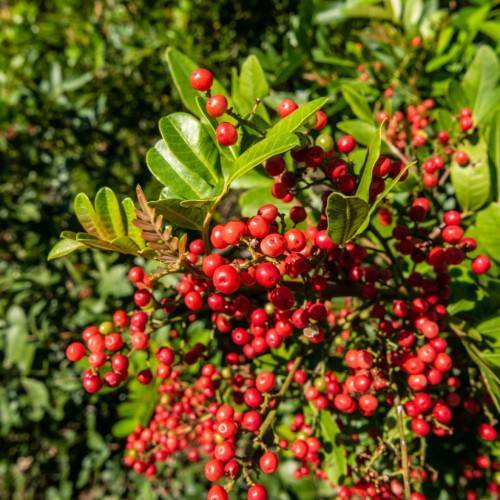
Brazilian peppertree
Schinus terebinthifolius
Cycle:
Perennial
Watering:
Average
Hardiness Zone:
9 - 11
Flowers:
Flowers
Sun:
Full sun
Fruits:
Fruits Ready In Fall
Leaf:
Yes
Growth Rate:
High
Maintenance:
Moderate
Drought Tolerant:
Yes
Salt Tolerant:
Yes
Invasive:
Yes
watering
The Brazilian peppertree requires regular watering throughout the growing season. Water the plant deeply whenever the soil is dry to the touch and check the moisture level at least once a week. During the summer months, this may require watering twice per week or more. In the winter months, reduce watering frequency to once every week or 2, depending on your climate and the amount of rainfall. Avoid over-watering, as this can lead to root rot and other pland health issues.
sunlight
The Brazilian peppertree (Schinus terebinthifolius) is best suited for full sun. It is able to tolerate some shade but its growth will be slower and the flavorful berries will not form in shade. It requires a minimum of 6 hours of direct sunlight each day for optimal growth and health. During the summer months from May to August when the days are long, it will thrive, and its berries will turn a vibrant red. In the autumn and winter months when the days are shorter, it will still do well, but the berries will turn black.
pruning
Pruning the Brazilian Peppertree (Schinus terebinthifolius) can help promote healthy growth within the plant and its root structure. It is best to prune this species of trees lightly during the spring or early summertime. This includes cutting off any diseased, damaged, or dead material. When it comes to the actual pruning process, many stems and limbs can be safely thinned out, up to 1-third of the leaves. Care should be taken to not remove too much foliage as this can lead to a decrease in the overall health of the plant. Additionally, be aware of the potential for the spread of diseases when pruning and it is always recommended to also sanitize pruning tools prior to use.
